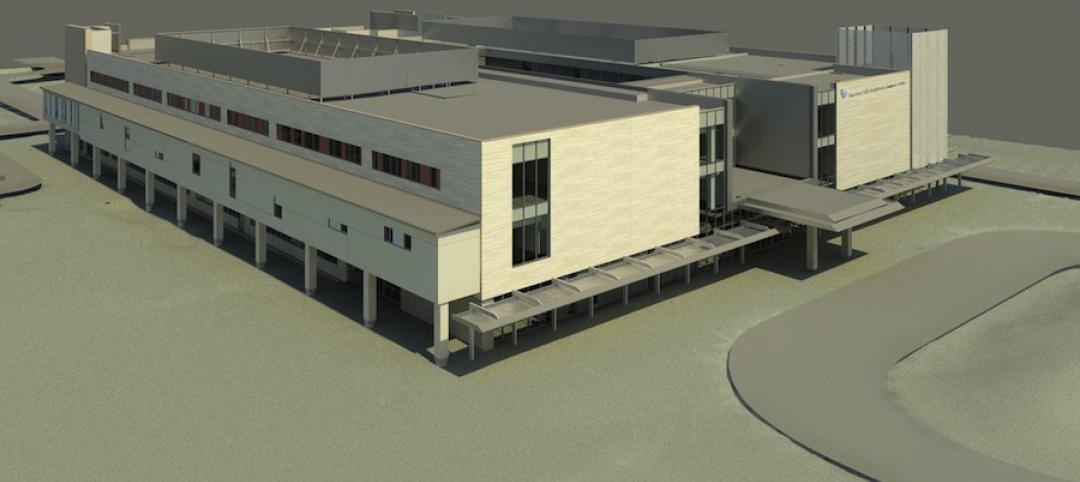 |
| Perkins+Will, with Pei Partnership Architects, designed Ronald Reagan UCLA Medical Center. |
Over the past 30 years or so, the healthcare industry has quietly super-sized its healthcare facilities. Since 1980, ORs have bulked up in size by 53%, acute-care patient rooms by 77%. The slow creep went unlabeled until recently, when consultant H. Scot Latimer applied the super-sizing moniker to hospitals, inpatient rooms, operating rooms, and other treatment and administrative spaces.
It's not just individual rooms that are bloated. Fourteen states are loaded up on more inpatient beds than population data suggests they'll need—for the next 21 years!—even as 14 other states are expected to suffer severe bed shortages (see chart, opposite). Latimer's message to hospital officials: invest wisely, because research shows that the healthcare sector will need a $2 trillion investment by 2030—$1 trillion in new construction, $1 trillion in infrastructure renewal. Super-sized spaces that do not contribute to functionality will be deemed wasteful and financially unsustainable, especially in today's economic environment.
Latimer, AIA, ACHA, a senior partner and managing director in the Denver office of Atlanta-based Kurt Salmon Associates and a past president of the AIA Academy of Architecture for Health, has made it his mission to raise awareness within the architecture community and among healthcare administrators of the need to right-size, not super-size, the nation's hospitals.
 |
Latimer has nearly three decades of data—based on 76 archived projects from client work dating back to 1980—that he's worked into a persuasive argument against super-sizing. At the AIA National Conference in San Francisco last June, he drew a standing-room-only audience.
Latimer sees healthcare designers in a bind. Many of them know their hospital projects are too big, but their fees are linked to project size. “There aren't enough architects to stand up and say, 'Make it smaller and spend money more wisely.'” Architects who do speak up are often challenged by clients who want their facilities designed for what Latimer calls the worst common denominator. “Architects can't abdicate their responsibilities to the leadership of the hospitals,” says Latimer. “They need to ask the hard questions and make the tough calls about what's really justified,” he says. “You can't just design a big room to fit everything and say, 'Boom, there you go, what's next?'”
Latimer says there is a great deal of confusion about how much investment is actually required for the healthcare sector and where beds are most needed. “People are staggered by how much demand there will be for beds in the coming years,” he says. For example, based on population projections through 2030, Arizona, California, Florida, Georgia, North Carolina, and Texas will need 80% of the country's new beds. California alone will need 63,000 new beds by 2030, which is the equivalent of building a new 200-bed hospital every month for the next 25 years, says Latimer.
 |
| The 365,000-sf, 181-bed Seton Medical Center-Williamson in Round Rock, Texas, is one of several recent UHS Building Solutions/HKS-designed healthcare projects that are considered right-sized. The design firm’s patient rooms average 275-300 sf, and at this hospital they come in at 291 sf. |
On the other hand, research indicates that states like New York and Pennsylvania have more than enough inpatient beds to meet demand through 2030. The logical solution, it would seem, would be to fund construction where beds are most needed. That's not the way the system works, however. Instead, many states that don't need more beds are building hospitals anyway.
As you can imagine, not everyone agrees with Latimer. They argue that designing larger spaces gives hospitals more flexibility to use a room for many different functions. But flexibility for what? asks Latimer. “Very seldom are ORs or other rooms changed into something else,” he says.
Others argue that because healthcare is getting more efficient, hospital stays are getting shorter, and more surgery is being done as outpatient procedures, the projection of $2 trillion in new construction and infrastructure is exaggerated. Latimer says, “Okay, say they're right. So, instead of $2 trillion over the next 20 years, we need $1 trillion. That's still a huge number, and there's a big responsibility to use that money wisely.”
To address that problem, Latimer says it is useful to examine three key questions: What has happened since 1980 that's led to hospital super-sizing? How is it possible to determine if increased square footage is justified? And, based on analysis of those two questions, how can hospital administrators and boards spend their capital resource funds most wisely?
A Closer Look at the Numbers
 |
| Since 1980, the healthcare industry has quietly super-sized its healthcare facilities. The average patient room grew by 77%. |
Total hospital size is traditionally based on about 1,500-2,500 gross sf per inpatient bed, but that rule of thumb varies wildly at the macro level, says Latimer, so it's easier to determine justified square footage of specific spaces, such as acute-care patient rooms, ORs, or shell space.
Acute-care patient rooms have swelled in size from around 170 net sf per patient 30 years ago to an average 300-320 net sf per patient today, a 77% increase that can be ascribed in large part to the transition to single-patient rooms. Other factors include ADA requirements for patient-room bathrooms, larger patient beds (they've grown from seven feet in length to almost nine feet over the years, which has super-sized corridors so beds can be turned around), and 24-hour family space—remember the quaint days of “visiting hours”?
“We're not hearing about any new or different functions coming into the patient room indicating it should grow larger, so any additional size would grow it beyond the needs of function,” says Latimer.
 |
| The average operating room increased in size by 53%. |
Operating rooms averaged 460 net sf in 1980; today, they run about 700-750 net sf, an increase of 53%. One reason for today's bigger ORs comes from a merging of technologies: procedures that used to be conducted in multiple smaller rooms now take place in larger single rooms.
Latimer says he has heard of some ORs hitting 1,000 sf. He questions how the additional 250 sf contributes to functionality. “We're not seeing any further merging or hybridization of technologies, and there hasn't been an increase in the number of people touching the patient in the sterile zone, so there's no reason for ORs to continue to grow,” he says.
He notes, too, that ORs are also the most expensive spaces to build—often three to four times more expensive than other parts of a hospital. Latimer concedes the point that, in some instances, a larger OR may be needed to accommodate such equipment as mobile CT or MRI, laminar flow, or robotic single-plane fluoroscopes. But he says that while one or two larger ORs in a surgical floor may be acceptable, an entire floor of super-sized ORs is not.
 |
| Perkins+Will’s 200-sf patient room for Salem Hospital’s North Shore Medical Center in Massachusetts meets family and caregiver needs. |
How much shell space is justified? According to Latimer, none—a very controversial zero—unless yours is one of the few hospitals that can justify the luxury of shell space. Otherwise shell space is simply not justifiable. “I think there's too much demand for space that isn't delivering any services, and the point is to eliminate everything unjustified,” he says.
His reasoning: hospitals should spend every dollar on beds they already have rather than on shell space for future beds. “Even if you know you'll need the beds in 10 years, build them in 10 years and spend the money on what you need now,” he says. At a time when most hospitals have more demands placed on them than they can afford to service, it makes no sense to spend money on shell space, says Latimer.
Latimer sees an obligation on the part of the healthcare AEC community to deliver the right-sizing message to their hospital clients—even if it's not always what the client wants to hear. “There will be a premium for architects who can deliver tight solutions that minimize size and costs,” says Latimer.
Related Stories
| Oct 30, 2013
15 stellar historic preservation, adaptive reuse, and renovation projects
The winners of the 2013 Reconstruction Awards showcase the best work of distinguished Building Teams, encompassing historic preservation, adaptive reuse, and renovations and additions.
| Oct 30, 2013
11 hot BIM/VDC topics for 2013
If you like to geek out on building information modeling and virtual design and construction, you should enjoy this overview of the top BIM/VDC topics.
| Oct 28, 2013
Urban growth doesn’t have to destroy nature—it can work with it
Our collective desire to live in cities has never been stronger. According to the World Health Organization, 60% of the world’s population will live in a city by 2030. As urban populations swell, what people demand from their cities is evolving.
| Oct 18, 2013
Meet the winners of BD+C's $5,000 Vision U40 Competition
Fifteen teams competed last week in the first annual Vision U40 Competition at BD+C's Under 40 Leadership Summit in San Francisco. Here are the five winning teams, including the $3,000 grand prize honorees.
| Oct 18, 2013
Researchers discover tension-fusing properties of metal
When a group of MIT researchers recently discovered that stress can cause metal alloy to fuse rather than break apart, they assumed it must be a mistake. It wasn't. The surprising finding could lead to self-healing materials that repair early damage before it has a chance to spread.
| Oct 14, 2013
The next level of Lean process for healthcare
Most hospitals have begun the Lean process improvement stage to eliminate waste, reduce travel distances, and minimize inventory, with varying levels of success. Here are three keys to creating a prosperous Lean program.
| Sep 24, 2013
8 grand green roofs (and walls)
A dramatic interior green wall at Drexel University and a massive, 4.4-acre vegetated roof at the Kauffman Performing Arts Center in Kansas City are among the projects honored in the 2013 Green Roof and Wall Awards of Excellence.
Sponsored | | Sep 23, 2013
Nichiha USA panels provide cost savings for community project
When tasked with the design and development of a newly constructed Gateway Rehabilitation Center, architects at Rothschild Doyno Collaborative first designed the new center to include metal panels. When the numbers came back, they were challenged with finding a product that would help cut costs and keep them within the construction budget. Nichiha’s fiber cement panels come in a half or less of the metal panel cost.
Sponsored | | Sep 23, 2013
HKS leverages Revu and Bluebeam Studio for IPD on the Banner Health MD Anderson Health Center project
Read how HKS is working collaboratively with all project partners and streamlining information flow using Bluebeam Revu and Bluebeam Studio to digitize communication and deliver the facility using IPD.
| Sep 19, 2013
What we can learn from the world’s greenest buildings
Renowned green building author, Jerry Yudelson, offers five valuable lessons for designers, contractors, and building owners, based on a study of 55 high-performance projects from around the world.
















